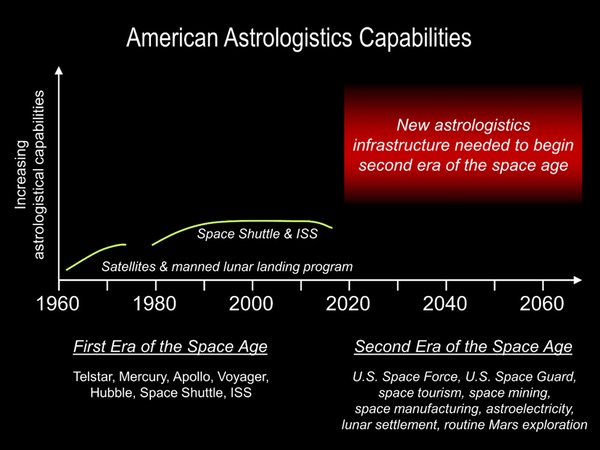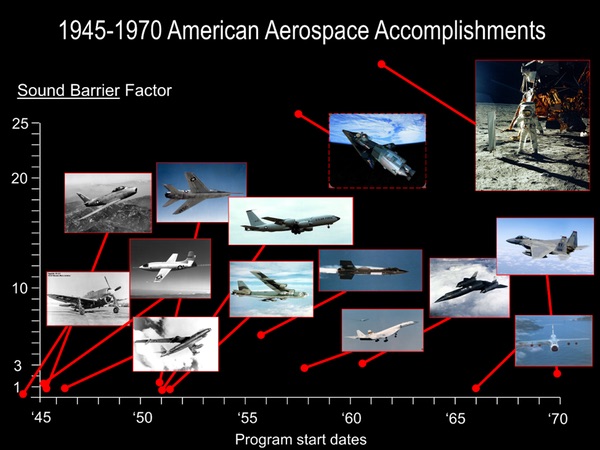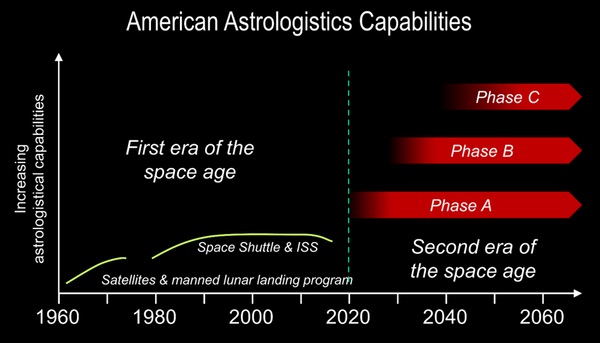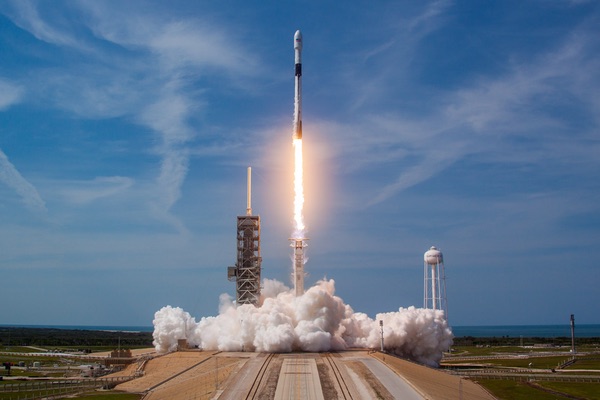Disruptive American “astrologistics”by Mike Snead
|
| America and the rest of the world are trapped in the equivalent of the “sailing” era of ocean-going exploration and commerce where human space enterprises remain dangerous and with success being highly uncertain. |
President Trump has called for a renaissance, a renewal, of America’s human space enterprise. Under the leadership of Vice President Mike Pence, the National Space Council was reestablished. President Trump endorsed the council’s call for a permanent American human presence on the Moon. At a council meeting on June 18, President Trump said, “My administration is reclaiming America’s heritage as the world’s greatest spacefaring nation.” On August 13, at the signing of the 2019 National Defense Authorization Act while speaking of his call for the creation of a US Space Force, he added, “We must have American dominance in space.” In saying this, President Trump has charged America’s aerospace industry with making this happen: of transforming America into a true human spacefaring nation. This is the modern equivalent of President Kennedy’s bold call to put an American safely on the Moon within the decade.
The world is awakening to the tremendous economic potential of the solar system’s extraterrestrial resources. Space probes are directly exploring asteroids and, soon, returning to the Moon to better understand their composition and structure. Space mining companies are forming to identify and extract economically valuable asteroid and lunar resources. Closer to home, space tourism, space-provided information, and space industrialization ventures aim to further commercially exploit Earth orbit. Finally, serious activities are underway that will, later this century, begin human civilization’s expansion off-world. President Trump’s leadership in renewing and strengthening America’s space enterprise is very timely as he is the political champion that has long been needed for these possibilities to begin to be realized. This is an exciting time for aerospace professionals!
The significant weakness of all of these efforts is that they are being undertaken absent a useful spacefaring logistics, or “astrologistics,” capability. America and the rest of the world are trapped in the equivalent of the “sailing” era of ocean-going exploration and commerce where human space enterprises remain dangerous and with success being highly uncertain. The lack of an integrated American national astrologistics infrastructure constrains fulfilling President Trump’s call for American dominance in space.
Building logistics infrastructure has been essential
The English word logistics evolved from the Greek logos—meaning reason—via the French logistique, meaning art of calculating. While the word logistics emerged in the mid-1800s, the function of logistics goes back into ancient times. As long as 4,600 years ago, the Egyptians were excellent logisticians in planning and executing the construction of the pyramids and other public works. Similar logistics efforts were evident in ancient China and in the pre-Columbian Americas.
For the United States, efforts to undertake “internal improvements”—as infrastructure was then called—began soon after the final withdrawal of British forces following the signing of the formal 1783 peace treaty. George Washington, after returning to Mount Vernon, began a quest that would last through the remainder of his lifetime to build a canal along the Potomac River to open trade to the interior of Virginia and on into the new Ohio Territory. Canals were soon followed by roads, steamship lines and, then, railroads as America eagerly built infrastructure to first enable the natural and agricultural wealth of the western territories to be affordably brought to market, and then to transport millions of settlers west to form new states, industrialize cities, and unite a continental nation. Public and private logistics infrastructure investment enabled the United States to enter the last century as an industrial and technological powerhouse, empowering it to prevail in two hot and one cold world wars.
| America is still operating within the first era of the space age, constrained by clearly inadequate astrologistics capabilities. |
An example of an important national logistics infrastructure that we all benefit from is the Dwight D. Eisenhower National System of Interstate and Defense Highways. Built at a current cost of over $500 billion, the system now has over 48,000 miles (77,200 kilometers) of highway. One-quarter of all vehicle miles are driven on these highways. It was created by the Federal-Aid Highway Act of 1956 championed by President Eisenhower. The concept dates back to a 1918 proposal by civil engineer E. J. Mehren for a 50,000-mile interstate highway system. The following year, a 28-year-old Lt. Col. Eisenhower participated in an arduous, two-month Army transcontinental road trip to assess the movement of the Army by road. A quarter century later, General Eisenhower viewed the German Reichsautobahn, seeing firsthand a modern highway system. These experiences prompted Eisenhower’s political support for the American interstate highway system that transformed personal and commercial ground mobility, providing the logistical underpinnings of substantial commercial and industrial growth and wealth generation.
The clear need for new astrologistics infrastructure
In the 1997 bestseller The Innovator’s Dilemma, Clayton M. Christensen emphasized the impact of disruptive technologies on established market leaders. With multiple examples, he highlights how companies bringing disruptive business ideas to market fundamentally altered how business is conducted. Competing companies that fail to respond fall behind, often going out of business.
However, disruption is not unique to business. Military forces have been introducing disruptive technologies ever since the first weapons were fashioned countless years ago. Almost all of America’s military space enterprise has been undertaken to exploit the military potential of robotic operations in outer space, seeking advantage over potential adversaries and deterrence against aggression. Yet, in the ensuing half century, American astrologistics—military and commercial—has changed little. Christensen provides a clue as to why in the following:
Companies whose investment processes demand quantifications of market sizes and financial returns before they can enter a market get paralyzed or make serious mistakes when faced with disruptive technologies. They demand market data when none exists and make judgements based upon financial projections when neither revenues or costs can, in fact, be known. Using planning and marketing techniques that were developed to manage sustaining technologies in the very different context of disruptive ones is an exercise in flapping wings.
 Figure 1: New American astrologistics infrastructure will be needed for America to begin the second era of the Space Age. (credit: J. M. Snead.) |
Figure 1 depicts America’s overall astrologistics capabilities since 1960. As noted by the Space Commission in 2001, America is still operating within the first era of the space age, constrained by clearly inadequate astrologistics capabilities. If we are to move into the second era, where America’s long-held true human spacefaring dreams and President Trump’s call for American dominance in space can be realized, new astrologistics infrastructure needs to be built.
The United States aerospace industry and military has not always been this timid. Figure 2 illustrates that the quarter century following the end of World War II saw the introduction and operational application of many new disruptive technologies, all accomplished within the slide-rule age of engineering. The once-thought impenetrable sound barrier speed of Mach 1 is used as the metric for plotting the program start dates and operational Mach numbers.
| A coordinated American investment in new astrologistics capabilities will be disruptive in terms of enabling dramatically better American national spacefaring capabilities. |
It is noteworthy that within less than a dozen years of the end of World War II, the military and its aerospace contractors had the self-confidence to begin developing the X-15, followed quickly by the start of development of the DynaSoar spaceplane and the B-70 Mach 3 strategic bomber. Within only a quarter-century of the end of Word War II, Americans were routinely flying hypersonically in reusable rocket-propelled aircraft, supersonically in operational military aircraft, and traveling to space, landing on the Moon. This is what American aerospace greatness looked like!
 Figure 2: Timeline of significant American aerospace advancements in the quarter century after the end of World War II. The program start year and operational Mach number is indicated. (credit: J. M. Snead.) |
A coordinated American investment in new astrologistics capabilities will be disruptive in terms of enabling dramatically better American national spacefaring capabilities. The starting point is what author Robert A. Heinlein noted back in 1950: that low Earth orbit (LEO) is the jumping off point for access to the rest of the solar system while we are still using chemical propulsion. Based on this, building an integrated American astrologistics infrastructure can be divided into three phases, enabling the second era of the space age to begin (see Figure 3):
- Phase A: Accessing LEO regularly and safely and creating the initial shared LEO astrologistics infrastructure.
- Phase B: Expanding the LEO common astrologistics infrastructure and extending this to medium- and geostationary Earth orbits (GEO), the Earth-Moon Lagrange points, lunar orbit, and the lunar surface.
- Phase C: Extending the common astrologistics infrastructure to support human and robotic exploration of Mars, near-Earth asteroids, and throughout Earth-Mars space.
 Figure 3: New astrologistics capabilities would enable the second era of the space age. (credit: J. M. Snead.) |
Building a shared American astrologistics infrastructure
To move effectively into the second era of the space age, America must leave “first era” thinking and organizational “ownership” behind. Just as the owners of a failing sports team recognize that a new general manager and coach are needed, America needs a new leadership structure to see to the building of an integrated astrologistics infrastructure meeting civil, military, and, eventually, private user needs. It is especially important that this be undertaken to make building the infrastructure the singular organizational objective unencumbered by competing responsibilities such as exploration, research, or national security.
As I have advocated before, creating a new Federal Government Corporation (FGC) chartered with establishing and operating the astrologistics infrastructure is now the appropriate step. (See “Should NASA build spacefaring logistics infrastructure?”, The Space Review, January 9, 2017.) This lets NASA continue to focus on its research, science, and exploration priorities; lets the Department of Defense establish a new US Space Force and US Space Guard; and lets private interests develop and implement business plans to exploit the new astrologistics infrastructure. With President Trump’s support, a new FGC could be organized and operating by the end of 2020 with a plan outlining the scope and capabilities of the new astrologistics infrastructure presented to the American public before the 2020 election.
President Trump has issued a call for America to dominate in space. It’s time to stop lollygagging and start building the infrastructure necessary for this call to be robustly answered. Building this infrastructure will disrupt the status quo in space operations, providing the United States with substantial operational advantages over potential adversaries and competing commercial interests.
Note: we are temporarily moderating all comments subcommitted to deal with a surge in spam.
